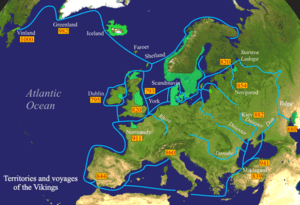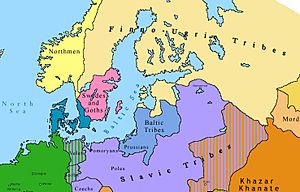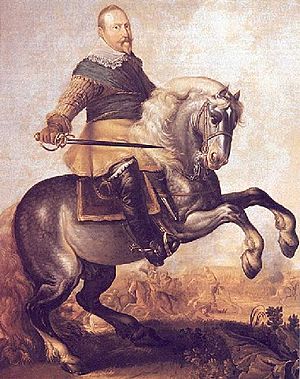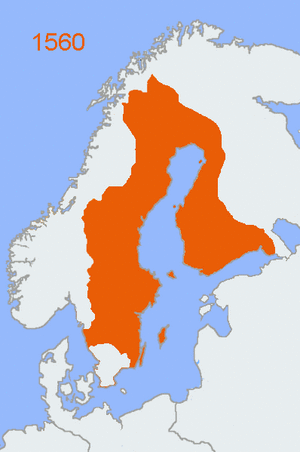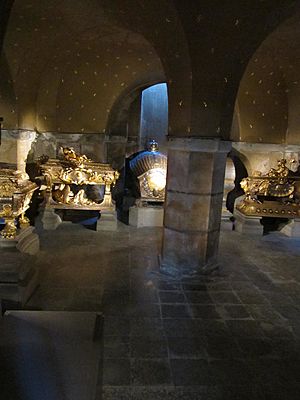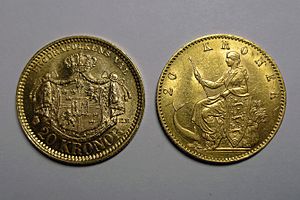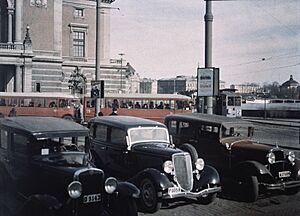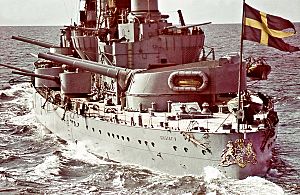History of Sweden facts for kids
The history of Sweden began a very long time ago, when the giant ice caps in the north started to melt. People have lived in this area since about 12,000 BC. During the Stone Age (8000–6000 BC), early people made tools and weapons from stone. They used these for hunting, gathering food, and fishing to survive. We don't have many written records about Sweden before the year 1000 AD. Most of what we know comes from people outside Sweden. Longer historical texts only started appearing in Sweden in the 1300s. So, most historians agree that Sweden's recorded history really begins around the 11th century, when there are enough sources to compare them.
The modern country of Sweden was formed slowly over many years. It involved different parts of the land coming together and becoming stronger. Some common laws started in the late 1200s. At that time, Sweden included most of what is now the southern part of the country (but not areas like Scania or Halland). It also included parts of modern Finland. Over the next few centuries, Sweden's influence spread north and east.
In the late 1300s, Sweden became closely connected with Denmark and Norway. Eventually, these three countries joined together in something called the Kalmar Union. For the next 100 years, Sweden often rebelled against this union. Sometimes, they even chose their own king. The biggest fight happened after the Stockholm Bloodbath in 1520. This was when Christian II of Denmark ordered many people to be executed. One important noble, Gustav Vasa, was not there. He started a new rebellion and became king in 1523. His rule lasted a long time and ended Sweden's part in the Kalmar Union. Gustav Vasa also supported new religious ideas. He broke away from the Roman Catholic Church and set up the Lutheran Church in Sweden. He took control of the Catholic Church's land and wealth.
During the 1600s, Sweden became a very powerful country. It won wars against Denmark-Norway, Russia, and the Polish-Lithuanian Commonwealth. Sweden took control of the Baltic region. Its role in the Thirty Years' War helped decide the political and religious power balance in Europe. Sweden grew much larger, taking over areas that are now Estonia, Latvia, northern Germany, and some regions still part of Sweden today.
Before the end of the 1600s, Denmark-Norway, the Polish-Lithuanian Commonwealth, and Russia secretly teamed up against Sweden. They attacked Sweden at the start of the 1700s. In 1721, Russia and its friends won the war against Sweden. Russia took over Swedish lands like Estonia, Livonia, Ingria, and Karelia. This ended the Swedish Empire and weakened Sweden's power in the Baltic Sea. Sweden then joined the Age of Enlightenment, a time of new ideas in art, science, and learning. Between 1570 and 1800, Swedish cities grew in two main periods. Finland was lost to Russia in a war from 1808 to 1809.
In the early 1800s, Sweden lost Finland and other lands outside the Scandinavian Peninsula. Sweden's last war was the Swedish–Norwegian War (1814). Sweden won this war, which forced the Danish king to give Norway to Sweden. Norway then had to join a special union with Sweden that lasted until 1905. Since 1814, Sweden has been at peace. It chose a policy of not taking sides in peacetime and staying neutral in wars. During World War I, Sweden remained neutral. It allowed Germans to travel through the country. After the war, Sweden became wealthy. This wealth helped create the social welfare programs that are common in modern Sweden. During World War II, Sweden was neutral again, avoiding being occupied like Norway.
Sweden tried to stay out of alliances and remained officially neutral during the entire Cold War. It did not join NATO. The Social Democratic party was in power for 44 years (1932–1976). In 1976, a different group of parties came to power. During the Cold War, Sweden was careful about the big superpowers. This feeling lessened over time, but Sweden continued to be neutral.
Contents
Sweden's Early History: Before 800 AD
Sweden has many ancient rock carvings, called hällristningar in Swedish. Most of them are found in the province of Bohuslän. The oldest carvings are in Jämtland and date back to 5000 BC. They show wild animals like elk, reindeer, bears, and seals. The busiest time for carving was between 2300 and 500 BC. These carvings show farming, battles, ships, and farm animals.
Viking Age and Middle Ages: 800–1500
For many centuries, Swedes were known as merchant sailors. They traveled far to trade. During the 1000s and 1100s, Sweden slowly became a single Christian kingdom. This kingdom later included Finland. Until 1060, the kings of Uppsala ruled most of what is now Sweden. But the southern and western coastal areas were controlled by Denmark until the 1600s. After 100 years of civil wars, a new royal family appeared. They made the king's power stronger and gave nobles special rights, like not having to pay taxes, if they served in the military. Sweden never had a full feudal system, and its farmers were never forced into serfdom. Swedish Vikings took part in raids in Western and Southern Europe. But they mostly traveled east to Russia, Constantinople, and the Muslim world. The large Russian mainland and its many rivers were good for trading and raiding. In the 800s, many Scandinavians started settling on the east side of the Baltic Sea.
Changing from Norse paganism to Christianity was a slow and sometimes violent process. Early Christian influence came mainly from England. This was because Scandinavians interacted with Saxons in the Danelaw and with Irish missionaries. German influence was less clear at first, even with an early missionary named Ansgar. But it slowly became the main religious power in the area, especially after the Norman conquest of England. Even though Swedish and Russian nobles were close, there is no direct proof of Orthodox influence.
Around the year 1000, Olof Skötkonung became the first known king to rule both Svealand and Götaland. We don't know many details about early medieval kings. Even the dates of their reigns are unclear. In the 1100s, Sweden still had struggles between the Erik and Sverker families. People in Svealand usually supported the Erik family. People in Götaland usually supported the Sverker family, who wanted better relations with Denmark. This divided the country. The country chose its king by having 12 local nobles from each district elect the king at the Stones of Mora. The division ended when a third family married into the Erik family. This created the Bjelbo dynasty. This family slowly made Sweden a strong state before the Kalmar Union. Sweden was probably not fully united until the mid-1200s.
In 1332, the king of Denmark, Christopher II, died without a country. King Magnus took advantage of Denmark's weakness. He bought lands in the eastern Danish provinces, including Scania, for a lot of silver. On July 21, 1336, Magnus was crowned king of Norway and Sweden in Stockholm. Scania was later taken back by the Danish king Valdemar in 1360.
During the early Middle Ages, the Swedish kingdom also expanded to control Norrland and Finland. This expansion caused problems with the Russian states. This tension continued throughout Swedish history.
After the Black Death (a terrible plague) and internal power struggles in Sweden, Queen Margaret I of Denmark united the Nordic countries in the Kalmar Union in 1397. The Swedish nobles approved this.
Early Modern Sweden: 1523–1611
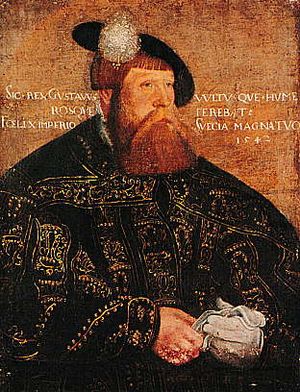
In the 1500s, Gustav Vasa (1490–1560) fought for an independent Sweden. He stopped attempts to bring back the Kalmar Union. He also laid the groundwork for modern Sweden. At the same time, he broke away from the Roman Catholic Church and set up the Lutheran Church in Sweden.
The final breakup of the Kalmar Union in the early 1500s led to a long rivalry between Norway and Denmark on one side, and Sweden on the other. The Catholic bishops had supported the Danish King Christian II. But he was overthrown by Gustavus Vasa, and Sweden became independent again. Gustavus used the Protestant Reformation to reduce the church's power. He was crowned King Gustavus I in 1523. In 1527, he convinced the Riksdag (Sweden's parliament, including nobles, clergy, townspeople, and free farmers) to take over church lands. These lands made up 21% of all farmland. Gustavus protected the Lutheran reformers and appointed his own bishops. He stopped nobles who opposed his church policies and his efforts to centralize power.

Tax reforms happened in 1538 and 1558. Many complicated taxes on independent farmers were simplified and made the same across the country. Taxes per farm were adjusted to match how much people could pay. The king's tax income increased. More importantly, people felt the new system was fairer. A war with Luebeck in 1535 led to the removal of Hanseatic traders. They used to control all foreign trade. With Swedish businessmen in charge, Sweden's economy grew quickly. By 1544, Gustavus controlled 60% of all farmland in Sweden. Sweden then built the first modern army in Europe. It was supported by a good tax system and government workers. Gustavus declared that the Swedish crown would be passed down through his family. The House of Vasa ruled Sweden (1523–1654) and Poland (1587–1668).
Sweden Becomes a Great Power
During the 1500s and 1600s, kings demanded more and more taxes and soldiers. They said it was for defense. But the money and people were used for attacking other countries. When there seemed to be a real threat of invasion in 1655–1660, King Charles X Gustav asked people to give more and manage their own defenses. Finally, a balance was found that allowed for an aggressive foreign policy. In the 1600s, Sweden (with only about 1 million people) became a great power. It won wars against Denmark, Russia, and Poland. Sweden took direct control of the Baltic region. This area was Europe's main source of grain, iron, copper, wood, tar, hemp, and furs.
Sweden first gained land outside its traditional areas in 1561. This happened when Estonia chose to become a part of Sweden during the Livonian War. In 1590, Sweden had to give up Ingria and Kexholm to Russia. And Sigismund tried to make Swedish Estonia part of the Duchy of Livonia. But Sweden slowly expanded in the eastern Baltic in the following years. In a series of wars with Poland (1600–1629) and Russia (the Ingrian War), Gustavus Adolphus took back Ingria and Kexholm (officially given to Sweden in the Treaty of Stolbovo, 1617). He also took most of Swedish Livonia (officially given in the Treaty of Altmark, 1629).
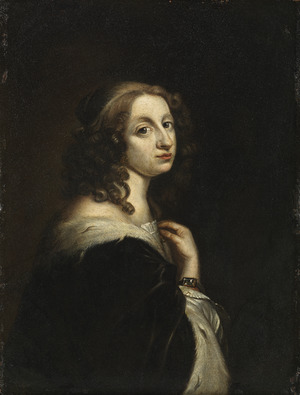
Sweden's role in the Thirty Years' War shaped the political and religious power balance in Europe. From areas like Stralsund (1628) and Pomerania (1630), the Swedish army moved south into the Holy Roman Empire. In another part of the war, the Torstenson War, Sweden took land from Denmark-Norway. This included Danish Estonia, Jämtland, Gotland, Halland, Härjedalen, and Idre and Särna. Sweden also no longer had to pay the Sound Dues (a tax on ships). All this was made official in the Treaty of Brömsebro (1645). In 1648, Sweden became a guarantor power for the Peace of Westphalia. This treaty ended the Thirty Years' War. It gave Sweden more lands like Bremen-Verden, Wismar, and Swedish Pomerania. From 1638, Sweden also had a colony called New Sweden along the Delaware River in North America.
Sweden as a Great Power: 1648–1721
In 1655, during the Second Northern War, Charles X Gustav of Sweden invaded and took over western Poland–Lithuania. Russia already occupied the eastern half. The quick Swedish advance was known in Poland as the Swedish Deluge. The Grand Duchy of Lithuania became a Swedish territory. The Polish–Lithuanian armies surrendered, and the Polish King John II Casimir Vasa fled. The Deluge lasted five years and caused huge damage to Poland and Lithuania. Some historians say this invasion started the downfall of the Polish-Lithuanian Commonwealth. The country was ruined, treasures were stolen, and many lives were lost.
Sweden gained control of the eastern side of the Sound. This was made official in the Treaty of Roskilde (1658). European great powers also recognized Sweden's southeastern lands in the Treaty of Oliva (1660). But Sweden was stopped from expanding further along the southern Baltic coast. Sweden came out of the Scanian War with only small losses. This was mostly because France forced Sweden's enemies into the treaties of Fontainebleau (1679) (confirmed at Lund) and Saint-Germain (1679).
The time of peace that followed allowed Charles XI of Sweden to improve and stabilize the country. He fixed the Crown's money problems with the great reduction of 1680. Other changes were made in money, trade, navy and army, legal procedures, church government, and education.
The Great Northern War: 1700
Russia, Saxony–Poland, and Denmark–Norway joined forces in 1700 and attacked the Swedish empire. The young Swedish King Charles XII (1682–1718; reigned 1697–1718) won amazing victories early in the Great Northern War. His most notable success was against the Russians at the Battle of Narva (1700). But his plan to attack Moscow and force Russia to make peace was too ambitious.
The Russians won a major victory at the Battle of Poltava in June 1709. They captured much of the tired Swedish army. Charles XII and the rest of his army were cut off from Sweden. They fled south into Ottoman territory, where he stayed for three years. He stayed too long, refusing to leave until the Ottoman Empire joined him in a new war against Tsar Peter I of Russia. He built a strong political network in Constantinople. This included even the sultan's mother. Charles's persistence worked, and Peter's army was stopped by Ottoman troops. However, the Turks did not follow up on their victory, which angered Charles. From that moment, his relations with the Ottoman government got worse. At the same time, his troops' behavior worsened and became disastrous. Lack of discipline and disrespect for the local people soon created a terrible situation in Moldavia. Meanwhile, back in the north, Sweden was invaded by its enemies. Charles returned home in 1714. It was too late to get back his lost empire and poor homeland. He died in 1718. In the peace treaties that followed, the allied powers, joined by Russia and Great Britain-Hanover, ended Sweden's time as a great power. Russia now controlled the north. The Riksdag, tired of war, took new powers. It reduced the king to a constitutional monarchy, where power was held by a civilian government controlled by the Riksdag. A new "Age of Freedom" began. The economy was rebuilt, helped by large exports of iron and wood to Britain. The Riksdag became an active parliament. This tradition continued into the 1800s, setting the stage for Sweden to become a modern democracy.
The reign of Charles XII (1697–1718) has caused much debate. Historians have wondered why this military genius pushed too far and greatly weakened Sweden. Some early 1800s historians praised him greatly. But others criticized him as a fanatic and a warmonger. A more balanced view suggests he was a very capable military ruler. His unusual traits seemed to help him, but he neglected his home country of Sweden while seeking adventures abroad. A group of nobles, called the "Hats", dreamed of revenge on Russia. They ruled the country from 1739 to 1765. They fought wars in 1741 and 1757. Russian influence grew in Sweden after the 1741 war. However, much of this influence was lost in 1790 after the Russo-Swedish war of 1788-1790.
The Enlightenment in Sweden
Sweden joined the Age of Enlightenment in its arts, architecture, science, and learning. A new law in 1766 for the first time allowed freedom of the press. This was an important step towards freedom of political opinion. The Academy of Science was founded in 1739. The Academy of Letters, History, and Antiquities was founded in 1753. The most important cultural leader was Carl Linnaeus (1707–78). His work in biology had a big impact on European science.
After 50 years of parliament ruling, the monarchy reacted. King Gustav III (1746–1792) became king in 1771. In 1772, he led a coup d'état (a sudden takeover of power) with French support. This made him an "enlightened despot," meaning he ruled as he wished but with modern ideas. The Age of Freedom and party politics was over. Gustav III was smart and well-educated. He supported the arts and music. His orders reformed the government, fixed the money, expanded trade, and improved defense. Gustav III weakened the power of the nobles and promoted many important social reforms. He believed the Swedish monarchy could survive by working with the new middle classes against the nobles. He did not like the French Revolution personally. But he decided to promote more anti-feudal reforms to strengthen his position among the middle classes.
After Gustav fought a war with Russia and did poorly, he was killed by a group of nobles. They were angry that he tried to limit their special rights for the benefit of the farmers. Under the next king, King Gustav IV, Sweden joined different groups against Napoleon. But Sweden was badly defeated and lost much of its land, especially Finland and Pomerania. The army overthrew the king. In 1810, they decided to bring in one of Napoleon's marshals, Jean Bernadotte, as the next king.
Swedish Colonies and Slavery
Sweden briefly tried to have colonies overseas. These included "New Sweden" in Colonial America and the "Swedish Gold Coast" in what is now Ghana. These started in the 1630s. Sweden bought the small Caribbean island of Saint Barthélemy from France in 1784. It then sold it back in 1878. The people on the island included slaves until the Swedish government freed them in 1847.
Early Growth of Cities
Between 1570 and 1800, Sweden saw two periods when its cities grew. These were from about 1580–1690 and in the mid-1700s. There was a quiet period in between. The first phase was more active. The number of people living in Stockholm increased. Many small new towns were also founded. This was similar to how other European capital and port cities grew. The second period of city growth began around 1750. This was because Swedish trade patterns shifted from the Baltic Sea to the North Atlantic. During this time, the populations in the small towns of the north and west grew.
The 19th Century in Sweden
Loss of Finland: 1809
Finland was lost to Russia in a war that lasted from February 1808 to September 1809. Because of the peace agreement, Finland became a Grand Duchy. This meant it was officially ruled by the Tsar of Russia, but it was not strictly part of Russia. Help from England did not stop Sweden from becoming more friendly with Napoleon after the Swedish coup d'état in 1809.
Union with Norway: 1814

In 1810, a French Marshal named Jean-Baptiste Bernadotte was chosen by the Riksdag to be Charles XIV John of Sweden (1818–44). He had a background in revolutionary ideas. But he put Sweden in the group that opposed Napoleon. In 1813, his forces joined the allies against Napoleon. They defeated the Danes at Bornhöved. In the Treaty of Kiel, Denmark gave mainland Norway to the Swedish king. However, Norway declared its independence, wrote a constitution, and chose a new king. Sweden invaded Norway to make them follow the Kiel treaty. After brief fighting, a peace agreement created a personal union between the two states. Even though they shared the same king, Norway was mostly independent of Sweden. Only Sweden controlled foreign affairs. The king's rule was not popular. When Sweden refused to let Norway have its own diplomats, Norway rejected the King of Sweden in 1905 and chose its own king.
During Charles XIV's reign, the first part of the Industrial Revolution reached Sweden. This early growth was based on rural metalworking shops, textile home industries, and sawmills.
The popularity of Charles XIV decreased for a time in the 1830s. This led to the Rabulist riots in 1838. This happened after a journalist was found guilty of insulting the king. Some people even called for the king to step down.
The 1800s saw the rise of liberal newspapers. Guilds (groups of craftsmen) lost their monopolies, allowing free enterprise. There were reforms in taxes and voting. National military service became compulsory. Three major political parties emerged: the Social Democratic Party, the Liberal Party, and the Conservative Party.
Modernizing Sweden: 1860–1910
Sweden, like Japan at the same time, changed from a slow rural society to a busy industrial one between the 1860s and 1910. Farming slowly changed from shared village land to more efficient private farms. There was less need for manual labor on farms. So, many people moved to cities. About a million Swedes moved to the United States between 1850 and 1890. Many returned and told stories about how productive American industry was. This helped Sweden modernize faster.
In 1873, Sweden and Denmark formed the Scandinavian Monetary Union.
The late 1800s saw the rise of opposition newspapers. Guilds lost their control over craftsmen. Taxes were reformed. Young men had to serve two years in the military, even though there was no war.
Health in Sweden
Death rates in Sweden began to steadily decline around 1810. For working-age men and women, the death rate trends were different. This led to more men dying than women during the first half of the century. There were very high rates of infant and child deaths before 1800. Among babies and children aged one to four, smallpox was a major cause of death in the 1770s–1780s. It then declined. Deaths also peaked during this time due to other diseases spread by air, food, and water. But these also declined in the early 1800s. The decline of several diseases during this time created a better environment. This increased children's ability to fight off disease and greatly lowered child deaths.
Compulsory gymnastics was introduced in Swedish schools in 1880. This was partly based on a long tradition of physical and mental training. More directly, promoting gymnastics as a scientific form of physical training happened at the same time as military conscription. This gave the state a strong interest in physically and mentally educating children to be citizen soldiers. Skiing is a major recreation in Sweden. It has had a big impact on Swedish national pride and identity. Swedes saw skiing as good, strong, heroic, in harmony with nature, and part of the country's culture. A growing sense of national feeling and appreciation for nature led to the creation of the Swedish Ski Association in 1892. This group aimed to combine nature, leisure, and nationalism. The organization focused on patriotic, military, heroic, and environmental Swedish traditions related to ski sports and outdoor life.
The 20th Century in Sweden
With more people able to vote, three major political parties emerged: the Social Democrats, the Liberals, and the Conservatives. The parties debated how to further expand voting rights. The Liberal Party, based on the middle class, proposed a plan for local voting rights in 1907. This was later accepted by the Riksdag. Most Liberals wanted men to own some property before they could vote. But the Social Democrats called for all men to be able to vote, without property limits. Farmers had a strong voice in the Riksdag and held a conservative view. But their numbers declined after 1900, slowly ending opposition to full voting rights.
Religion remained important. But public school religious education changed. It went from strict learning of the Lutheran catechism to studies about the Bible and ethics.
Sweden in World War I
Sweden was neutral in World War I. However, the Swedish government was sympathetic to both sides at different times. It even briefly occupied the Åland islands together with the Germans. At first, the Swedish government considered changing its neutral stance to side with the Central Powers. It made concessions to them, including placing mines in the Öresund straits to block Allied warships from entering the Baltic Sea. Later, Sweden signed agreements allowing trade with the Allied powers and limiting trade with the Central Powers. This led to the fall of the government of Hjalmar Hammarskjöld.
Industrialization: 1910–1939
During World War I and the 1920s, Sweden's industries grew. They met Europe's demand for Swedish steel, ball bearings, wood pulp, and matches. The wealth after the war provided the basis for the social welfare policies that are typical of modern Sweden.
The Welfare State
Sweden created a successful model of social democracy. This was because Sweden's labor leaders, politicians, and different social classes worked together in a special way. This happened during the early development of Swedish democracy. Sweden's socialist leaders chose a moderate path of reforms. This had wide public support. This helped Sweden avoid the extreme challenges and divisions that affected many European countries trying to develop social democratic systems after 1911. By dealing early, cooperatively, and effectively with the challenges of industrialization, Swedish social democrats created one of the most successful social democratic systems in the world. This included both a welfare state and strong protections for civil liberties.
When the Social Democratic Party came to power in 1932, its leaders introduced a new way of making political decisions. This later became known as "the Swedish model" or the Folkhemmet (The People's Home). The party played a central role. But it tried as much as possible to base its policies on mutual understanding and compromise. Different interest groups were always involved in official committees that came before government decisions.
Foreign Policy: 1920–1939
Foreign policy concerns in the 1930s focused on Russia and Germany expanding their power. Sweden tried, but failed, to cooperate on defense with other Nordic countries.
Sweden During World War II
Sweden followed a policy of armed neutrality during World War II. However, thousands of Swedish volunteers fought in the Winter War with Finland against the Soviets. Sweden did allow German troops to pass through its territory to and from Norway. It also supplied the Nazi regime with steel and ball-bearings.
For decades after the war, historians often used the "small state realist" argument. This said that neutrality and cooperation with Germany were necessary for survival. This was because Germany was much more powerful. Concessions were limited and only made when the threat was too great. Neutrality was bent but not broken. National unity was most important. And in any case, Sweden had the neutral right to trade with Germany. Germany needed Swedish iron. Sweden had nothing to gain and much to lose from an invasion. The country was run by a national unity government. This included all major parties in the Riksdag except the communist party. Its key leaders included Prime Minister Per Albin Hansson, King Gustav V, and Foreign Minister Christian Günther.
Swedish diplomat Raoul Wallenberg helped Jews facing the Holocaust. As the secretary of the 1944 Swedish delegation to Hungary, he helped coordinate aid for the Jews of Europe during the Holocaust. He helped rescue tens of thousands of Jews in Nazi-occupied Hungary in late 1944. He disappeared in January 1945 and probably died in a Soviet prison in 1947.
Post-War Sweden
Sweden was one of the first countries not involved in World War II to join the United Nations (in 1946). Other than this, the country tried to stay out of alliances. It remained officially neutral during the entire Cold War, never joining NATO.
The Social Democratic party held government for 44 years (1932–1976). They spent much of the 1950s and 1960s building Folkhemmet (The People's Home), which is the Swedish welfare state. Sweden's industry was not damaged by the war. So, it was able to help rebuild Northern Europe in the decades after 1945. This led to an economic boom after the war, which made the welfare system possible. However, by the 1970s, the economies of the rest of Western Europe were doing well and growing fast. The Swedish economy, however, slowed down. Many economists blamed its large public sector, which was funded by taxes.
In 1976, the Social Democrats lost their majority. The 1976 parliamentary elections brought a liberal/right-wing group of parties to power. Over the next six years, four different governments ruled and fell. These were made up of some or all of the parties that won in 1976. The fourth liberal government faced criticism from Social Democrats and trade unions. This led to the Social Democrats regaining power in 1982.
During the Cold War, Sweden had two approaches. Publicly, it strongly maintained its strict neutrality policy. But unofficially, it kept strong ties with the U.S., Norway, Denmark, West Germany, and other NATO countries. Swedes hoped that the U.S. would use regular and nuclear weapons if the Soviets attacked Sweden. Sweden maintained a strong ability to defend against a sea invasion. This included Swedish-built warplanes. But it did not have long-range bombing capabilities.
In the early 1960s, U.S. nuclear submarines with Polaris A-1 nuclear missiles were placed near the Swedish west coast. Their range and safety made this a good area to launch a nuclear strike on Moscow if needed. The U.S. secretly gave Sweden a military security promise. It promised to provide military help to Sweden in case of Soviet aggression. As part of this military cooperation, the U.S. greatly helped in developing the Saab 37 Viggen. A strong Swedish air force was seen as necessary to keep Soviet anti-submarine aircraft from operating in the missile launch area. In return, Swedish scientists at the Royal Institute of Technology made important contributions to improving the targeting of the Polaris missiles.
On February 28, 1986, the Social Democratic leader Prime Minister Olof Palme was assassinated. The killer was never found. Shocked Swedes worried if the nation had lost its innocence.
In 1995, a few years after the Cold War ended, Sweden joined the European Union. The old term "policy of neutrality" was no longer used. In a referendum held in 2003, most people voted not to adopt the Euro as the country's official currency. Foreign Minister Anna Lindh was murdered just before the referendum.
During the 1980s, Sweden tried to keep its system of capitalism plus a generous welfare state. It called this a "bridging policy." Unintended problems appeared in the 1990s. There was an economic crisis with high unemployment. Several banks and companies went bankrupt. There was also high inflation, overheated real estate and financial markets, and negative real interest rates. After 1991, these factors caused a recession with high unemployment. There were political reactions, and businesses called for neoliberal government policies. By 2000, however, positive trends became dominant. Compared to the rest of Europe, unemployment in Sweden was low. Economic growth was high, inflation was low, the budget was balanced, and the balance of payments was positive.
Sweden's Foreign Policy
Sweden's foreign policy has changed over the centuries. Here are some key points:
- Sweden has historically tried to be neutral. This means it aimed to avoid getting involved in fights between big powers. This neutrality helped Sweden navigate Europe's difficult political landscape and keep its independence. In 2022–2023, it dropped its neutrality policy because of the Russian invasion of Ukraine. It is now trying to join NATO.
- Sweden has tried to keep a balance of power in Northern Europe. It acted as a counterweight to powerful countries in the region. This aimed to stop any single power from becoming too strong and threatening Swedish interests.
- Sweden's historical control in the Baltic Sea region was very important for its diplomatic history. By expanding its territory, Sweden gained control over important lands. These included modern-day Finland, Estonia, Latvia, and parts of Russia. This affected its relationships with neighboring countries.
- During the 1600s and 1700s, Sweden became a major European power. It took part in wars like the Thirty Years' War and the Great Northern War. Its diplomatic efforts were often shaped by power struggles with other big European powers, like Russia and Poland.
- Sweden has actively worked to mediate peace. It has tried to resolve conflicts and arrange peace agreements. Important examples include the Treaty of Westphalia in 1648, which ended the Thirty Years' War. It also made various mediation efforts in the 1900s.
- Sweden has a long tradition of promoting international cooperation, human rights, and humanitarian help. It has been involved in setting up international organizations like the League of Nations and the United Nations. It has supported causes like humanitarian aid and disarmament.
- Sweden has sought close ties and cooperation with its neighboring Nordic countries. These include Denmark, Finland, Iceland, and Norway. This commitment to Scandinavian unity has been shown in diplomatic efforts, trade agreements, and cultural exchanges.
- Sweden's relationship with the European Union (EU) has been a big part of its recent diplomatic history. Sweden joined the EU in 1995. But it has kept a somewhat careful approach, often balancing its national interests with its EU membership.
- Sweden has supported global development. It has provided a lot of aid to developing countries. It has tried to address global inequalities and promote sustainable development through its aid programs. It often challenges old colonial practices.
- In the 2000s, Sweden gained attention for its feminist foreign policy. This policy aims to include gender equality in its diplomatic efforts. Sweden has been a leading supporter of women's rights globally. It emphasizes including and empowering women in peacebuilding, conflict resolution, and development processes.
|
See Also
 In Spanish: Historia de Suecia para niños
In Spanish: Historia de Suecia para niños
- Flag of Sweden
- Foreign relations of Sweden#History
- History of Denmark
- History of Europe
- History of Finland
- History of Germany
- History of Norway
- History of Russia
- History of Scandinavia
- History of Sweden (1772–1809)
- History of the European Union
- List of prime ministers of Sweden
- List of Swedish monarchs
- List of Swedish people
- Military history of Sweden
- Political unions involving Sweden
- Politics of Sweden
- Privy Council of Sweden
- Riksdag of the Estates
- Sami history



